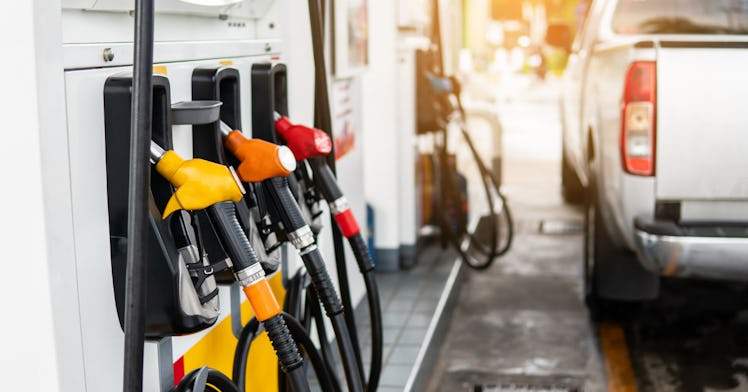This Map Shows The States Where Gas Costs the Most
Gas prices have skyrocketed, in some states more than others. Biden has a (somewhat controversial) plan to tackle it.

There is no question that affording life has been more challenging than usual over the past several months. Unfortunately, one of the more challenging hits to our wallet has been at the gas pump, which has increased significantly. However, while gas prices still feel out-of-control high, things are getting a little better – and help is on the way. Here’s what you need to know.
According to data collected by FinanceBuzz, the average driver spends 2.24 percent of their monthly income on gas – and more if you’re driving a fuel-inefficient SUV or truck. However, the data, which FinanceBuzz collected from AAA, the U.S. Census Bureau, and the U.S. Department of Transportation, shows that some drivers need to fork over 3.12 percent of their income to go toward gas.
As with anything, not all states are hit the same regarding how much income is going toward gas each month. Some are way above the average across the country. Others fall just below.
The states hardest hit with spending more on gas than others are primarily in the Southern region of the U.S., which accounts for six of the top 10 states. This includes Mississippi, Florida, Arkansas, and Alabama.
Looking closer at the numbers, the top five states where more monthly income is needed to go towards pay for gas are significantly higher than the national average.
Top five states where you spend the most monthly income on gas:
- Alabama spends 5.55 percent of monthly income on gas for cars and 7.71 percent on trucks and SUVs.
- Wyoming spends 4.91 percent on cars, 6.82 percent on trucks and SUVs
- Mississippi spends 4.83 percent on cars, 6.71 percent on trucks and SUVs
- Arkansas spends 4.70 percent on cars, 6.54 percent on trucks and SUVs
- New Mexico spends 4.57 percent on cars, 6.36 percent on trucks and SUVs.
Fatherly / Source: FinanceBuzz analyzed data from the U.S. Department of Transportation, U.S. Census Bureau
A poll done by DebtHammer, which asked more than 500 Americans how gas prices were impacting their lives, found that 75 percent of drivers said they’re financially feeling the impact of rising gas prices.
While this seems grim – those percentages are way too high, there is some help on the way from the federal government. While bills have been introduced in the federal government and in statehouses that would send residents money for gas, President Joe Biden is slated to announce new steps to address the rising gasoline process across the country. These measures will include releasing gas from oil reserves and issuing an emergency waiver that will allow year-round sales of ethanol-blend gasoline.
Why the release of ethanol-blend gasoline is controversial
“The sale of E15 gasoline is usually prohibited from June to mid-September because of air quality concerns,” CNN explains.
Indeed, ethanol is “potentially even dirtier than regular gasoline,” and can increase the risk of smog in hot, summer months, per reporting from The Verge. Though most gasoline is already mixed with some amount of ethanol, gasoline mixed with ethanol has been illegal to sell in the summer months since 2011 because it can lead to more smog and more greenhouse gas emissions in the summer month, a major concern as climate change reaches a tipping point globally.
However, given the “current circumstance, which is a fuel supply emergency,” lifting this ban temporarily is estimated to save consumers 10 cents per gallon on average and reduce the need to look to foreign fuels (because it can be made with corn, grown in America, per CNN.
“Those savings can add up, especially during the summer months, when fuel is elevated and as the supply emergency caused by [Russian President Vladimir] Putin’s aggression continues,” a senior administration official said.